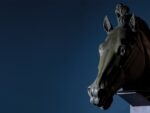Jan Fabre – Knight of the Night
 (480x324).jpg)
Mostra personale
Comunicato stampa
Ronchini Gallery is pleased to present Jan Fabre’s first UK solo exhibition, Knight of the Night. The exhibition features works spanning from 1992 to 2013, brought together for the first time to form a single narrative centred on courtly romance, one of the pivotal themes in the artist’s oeuvre.
Widely considered to be one of the most significant artists based in Belgium today, for over 35 years Jan Fabre has created work as an artist and author across theatre and visual arts. Using a wide range of media - including drawings, sculpture, installation, film and performance – Fabre’s work explores the body, from its fragility and defence mechanisms, to a broader observation of the behaviour of human beings, and questioning how they will survive in the future. The scarab beetle plays a major role in Fabre’s work and relates to a fascination with science dating back to his youth; influenced by the 19th-century French entomologist Jean-Henri Fabre, he would dissect insects and transform them into new creatures. One of his most recognisable works to date is Heaven of Delight (2002) a permanent installation covering the ceiling in the Mirror Room at the Royal Palace in Brussels with scarab wing cases. A recent permanent sculpture by Fabre can also be seen at the Cathedral of Our Lady in Antwerp; titled The man who bears the cross (2015), this bronze sculpture is directed at another work in the cathedral, Rubens’ masterpiece The Descent of the Cross (1611-1614).
Left: Jan Fabre, Untitled, 1994, Bic ballpoint pen and watercolour on paper, 233 x 150cm. Photo Claudio Abate, courtesy the artist and Ronchini Gallery
Right: Jan Fabre, Metamorphose, 1992, Bic ballpoint pen and watercolour on paper, 236 x 150cm. Photo Claudio Abate, courtesy the artist and Ronchini Gallery
The works presented in this exhibition explore the primary preoccupations of the artist’s practice, such as metamorphosis and the relationships between animals and humans, as well as life and death. The curatorial concept takes its departure from the performance film Lancelot (2004) which saw Fabre battle against himself in front of the camera for five hours, weighed down in heavy armour in a cold and dark location.
Highlights from the exhibition include suits of armour (works from 1997) created from thousands of wing-cases from the iridescent jewel (scarab) beetles. In Salvator Mundi (1998) iron armour, black beetle shells and a spinal column become a single sculpture. Skull sculptures materialise the dreams and nightmares that hover inside this night-time fairy-tale. Human skulls built with colourful mixtures of jewel beetle wing-cases clasp prey such as a taxidermy magpie, leather whips and the iron keys of hell; skulls become messengers of vanity and vigilance with historical references to the Belgian colonisation of Congo.
Also included in the exhibition are Fabre’s prolific drawings, characterised by his distinctive use of a Bic ballpoint pen.
Top left: Jan Fabre, Armour (Breast), 1997, beetles on iron wire, 46 x 41 x 22.5cm. Photo Claudio Abate, courtesy the artist and Ronchini Gallery
Top right: Jan Fabre, Armour (Breast), 1997, beetles on iron wire, 50 x 36 x 24cm. Photo Claudio Abate, courtesy the artist and Ronchini Gallery
Bottom left: Jan Fabre, Salvator Mundi, 1998, buprestids, iron, angel's hair, bones, 50 x 20 x 40cm. Photo Claudio Abate, courtesy the artist and Ronchini Gallery
Bottom right: Jan Fabre, Armour (Leg), 1997, beetles on iron wire, 81 x 29 x 21cm. Photo Claudio Abate, courtesy the artist and Ronchini Gallery
Born in 1958 in Antwerp, Jan Fabre studied at the Royal Academy of Fine Arts and the Municipal Institute of Decorative Arts and Crafts in Antwerp in the late 1970s. He lives and works in Antwerp. His work has been the subject of major exhibitions worldwide including: Homo Faber, KMSKA, Antwerp (2006); Hortus/Corpus, Kröller-Müller Museum, Otterlo (2011); Stigmata. Actions & Performances 1976–2013, MAXXI, Rome (2013) and the MHKA - Museum of Contemporary Art, Antwerp (2015). He was the first living artist to present his work at the Louvre in Paris (The Angel of Metamorphosis, 2008). His famous The Hour Blue series (1977–1992) has been shown at the Kunsthistorisches Museum in Vienna (2011), the Musée d’Art Moderne in Saint-Étienne (2012), and the Busan Museum of Art, South Korea (2013). His research on the human brain has resulted in exhibitions including: Anthropology of a Planet, Palazzo Benzon, Venice (2007); From the Cellar to the Attic. From the Feet to the Brain, Kunsthaus, Bregenz (2008) and the Arsenale Novissimo, Venice (2009), and Pietas, Nuova Scuola Grande di Santa Maria della Misericordia, Venice (2011). The two series of mosaics entitled Tribute to Belgian Congo (2010–2013) and Tribute to Hieronymus Bosch in Congo (2011–2013) were exhibited at the Palais des Beaux-Arts in Lille, France (2013) and the PinchukArtCentre in Kiev, Ukraine (2013). Jan Fabre has been invited to create a large-scale exhibition at the State Hermitage Museum in Saint Petersburg in 2016.



